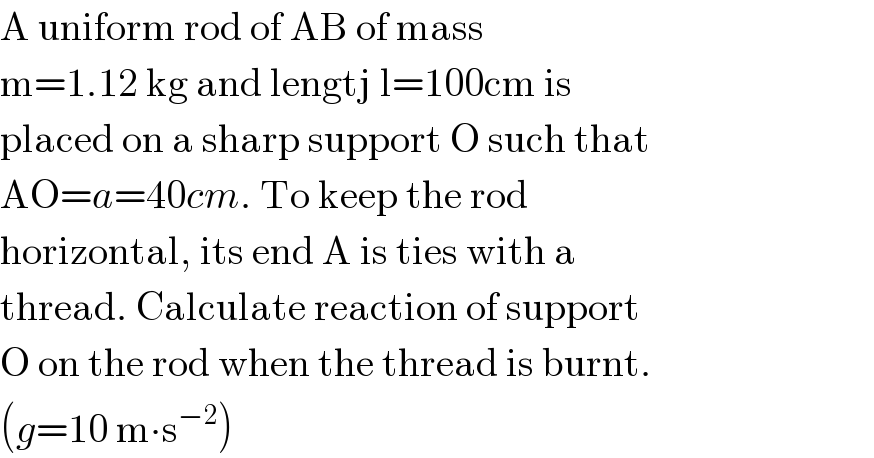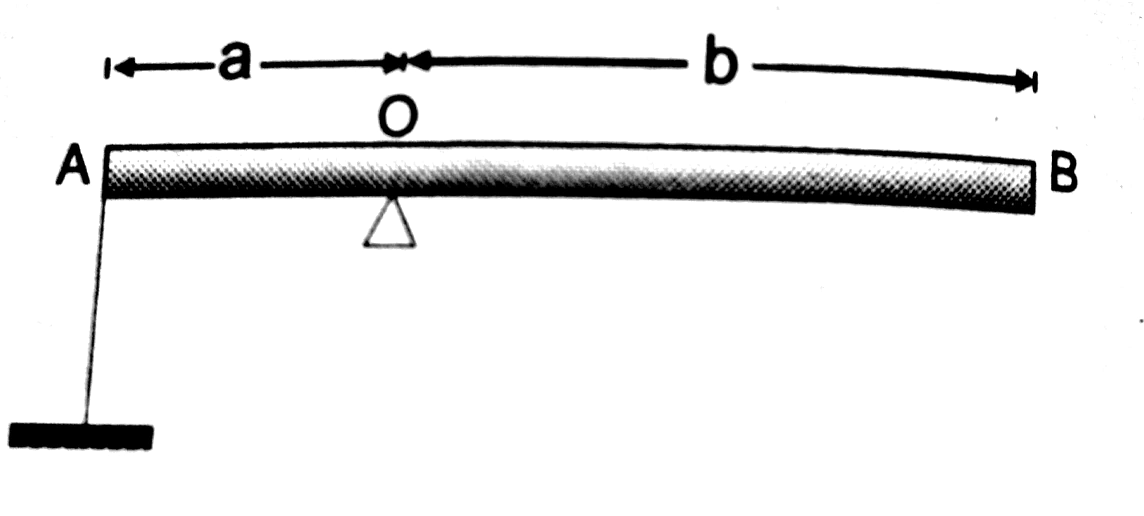Question Number 24460 by sushmitak last updated on 18/Nov/17

$$\mathrm{A}\:\mathrm{uniform}\:\mathrm{rod}\:\mathrm{of}\:\mathrm{AB}\:\mathrm{of}\:\mathrm{mass} \\ $$$$\mathrm{m}=\mathrm{1}.\mathrm{12}\:\mathrm{kg}\:\mathrm{and}\:\mathrm{lengtj}\:\mathrm{l}=\mathrm{100cm}\:\mathrm{is} \\ $$$$\mathrm{placed}\:\mathrm{on}\:\mathrm{a}\:\mathrm{sharp}\:\mathrm{support}\:\mathrm{O}\:\mathrm{such}\:\mathrm{that} \\ $$$$\mathrm{AO}={a}=\mathrm{40}{cm}.\:\mathrm{To}\:\mathrm{keep}\:\mathrm{the}\:\mathrm{rod} \\ $$$$\mathrm{horizontal},\:\mathrm{its}\:\mathrm{end}\:\mathrm{A}\:\mathrm{is}\:\mathrm{ties}\:\mathrm{with}\:\mathrm{a} \\ $$$$\mathrm{thread}.\:\mathrm{Calculate}\:\mathrm{reaction}\:\mathrm{of}\:\mathrm{support} \\ $$$$\mathrm{O}\:\mathrm{on}\:\mathrm{the}\:\mathrm{rod}\:\mathrm{when}\:\mathrm{the}\:\mathrm{thread}\:\mathrm{is}\:\mathrm{burnt}. \\ $$$$\left({g}=\mathrm{10}\:\mathrm{m}\centerdot\mathrm{s}^{−\mathrm{2}} \right) \\ $$
Commented by sushmitak last updated on 18/Nov/17

Commented by ajfour last updated on 18/Nov/17
![Torque about O : mg(((b−a)/2)) =[((ml^2 )/(12))+m(((b−a)/2))^2 ]α ⇒ α = ((6g(b−a))/(l^2 +3(b−a)^2 )) Also mg−N_O = mα(((b−a)/2)) ⇒ N_O =mg−((3mg(b−a)^2 )/(l^2 +3(b−a)^2 )) N_O = ((mg)/(1+3(((b−a)/l))^2 )) . =((11.2)/(1+0.12)) = 10 N .](https://www.tinkutara.com/question/Q24470.png)
$${Torque}\:{about}\:{O}\:: \\ $$$$\:\:{mg}\left(\frac{{b}−{a}}{\mathrm{2}}\right)\:=\left[\frac{{ml}^{\mathrm{2}} }{\mathrm{12}}+{m}\left(\frac{{b}−{a}}{\mathrm{2}}\right)^{\mathrm{2}} \right]\alpha \\ $$$$\Rightarrow\:\alpha\:=\:\frac{\mathrm{6}{g}\left({b}−{a}\right)}{{l}^{\mathrm{2}} +\mathrm{3}\left({b}−{a}\right)^{\mathrm{2}} } \\ $$$${Also}\:\:\:\:{mg}−{N}_{{O}} \:=\:{m}\alpha\left(\frac{{b}−{a}}{\mathrm{2}}\right) \\ $$$$\Rightarrow\:{N}_{{O}} ={mg}−\frac{\mathrm{3}{mg}\left({b}−{a}\right)^{\mathrm{2}} }{{l}^{\mathrm{2}} +\mathrm{3}\left({b}−{a}\right)^{\mathrm{2}} } \\ $$$$\:\:\:\:\:\:\boldsymbol{{N}}_{{O}} =\:\frac{{mg}}{\mathrm{1}+\mathrm{3}\left(\frac{{b}−{a}}{{l}}\right)^{\mathrm{2}} }\:\:\:. \\ $$$$\:\:\:\:\:\:\:\:\:\:\:\:\:=\frac{\mathrm{11}.\mathrm{2}}{\mathrm{1}+\mathrm{0}.\mathrm{12}}\:=\:\mathrm{10}\:{N}\:. \\ $$
Commented by sushmitak last updated on 18/Nov/17

$$\mathrm{Thank}\:\mathrm{You}\:\mathrm{very}\:\mathrm{much}\:\mathrm{Sir}! \\ $$
